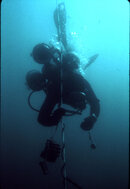Okay, I’m a very old wetsuit diver, who’s never used open cell wetsuits. I cannot see how they would be warmer at the same thickness as a closed-cell wetsuit. Please explain that to me? Open-cell means that water can come into the wetsuit material, at least that is my interpretation of the term. Water dramatically removes more heat than air bubbles or nitrogen bubbles in a close-cell wetsuit. To me, that precludes this style from being “warmer.” Again, please explain.
I have used wetsuits in freezing water, without problems. The main problem with a closed-cell wetsuit is when going deeper, and the suit itself compresses, loosing a lot of its heat-retaining properties. At 100 feet, the wetsuit is not real warm in freezing water, and a dry suit is required.
I have used a hooded vest, and also in the ol’ days we used a jacket with an attached hood successfully in very cold water. Now, it is difficult to get a custom-cut wetsuit (one made exactly to your body dimensions), and also the use of stitching by some manufacturers causes holes in each seam, which pump water in and out, making the modern wetsuit much colder than their predecessors. We used to have “skin one side” wetsuits, which were blind-stitched on the nylon side. We wore them “skin-in” so that we needed to use corn starch to get into them, but when taken off they dried quickly and were still warm for the second dive.
SeaRat
I have used wetsuits in freezing water, without problems. The main problem with a closed-cell wetsuit is when going deeper, and the suit itself compresses, loosing a lot of its heat-retaining properties. At 100 feet, the wetsuit is not real warm in freezing water, and a dry suit is required.
I have used a hooded vest, and also in the ol’ days we used a jacket with an attached hood successfully in very cold water. Now, it is difficult to get a custom-cut wetsuit (one made exactly to your body dimensions), and also the use of stitching by some manufacturers causes holes in each seam, which pump water in and out, making the modern wetsuit much colder than their predecessors. We used to have “skin one side” wetsuits, which were blind-stitched on the nylon side. We wore them “skin-in” so that we needed to use corn starch to get into them, but when taken off they dried quickly and were still warm for the second dive.
SeaRat






